The Razer Blade Stealth Review: Razer Takes On The Ultrabook
by Brett Howse on March 29, 2016 8:00 AM EST- Posted in
- Laptops
- Razer
- Skylake
- Razer Blade Stealth
- eGFX
- Razer Core
- Skylake-U
GPU Performance
The Core i7-6500U features an Intel HD 520 graphics processor, which is a 24 execution unit (EU) configuration of Intel’s Gen 9 graphics. Intel has been focusing on graphics performance quite a bit over the last several generations, and the integrated solutions are now fairly capable. Intel also has the Iris graphics, which is a 48 EU version of this GPU and it also includes eDRAM. With Razer’s gaming pedigree it would have been nice to see this as an option on the higher model unit, but likely due to pricing and availability of the Iris parts, they have elected to stick with the standard Ultrabook part, and supplement it with an optional external graphics dock in the Razer Core. As much as this isn’t a gaming device, the addition of Iris graphics would likely have a significant impact on its capabilities, but for normal desktop tasks and light gaming, the HD 520 should do the trick.
3DMark
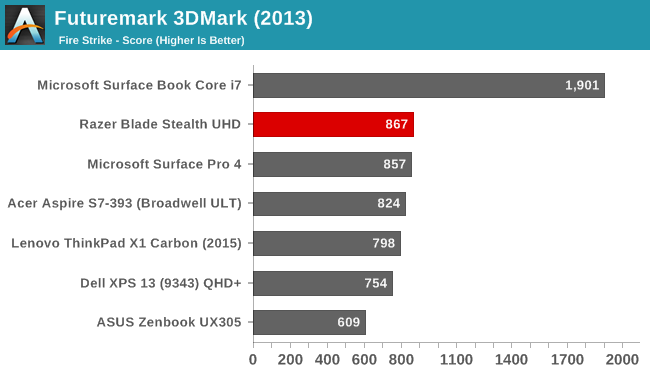
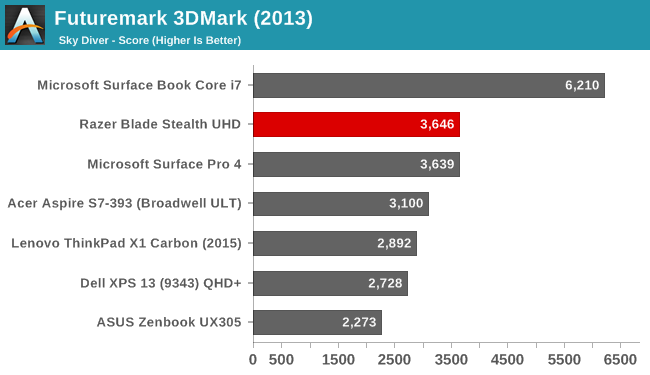
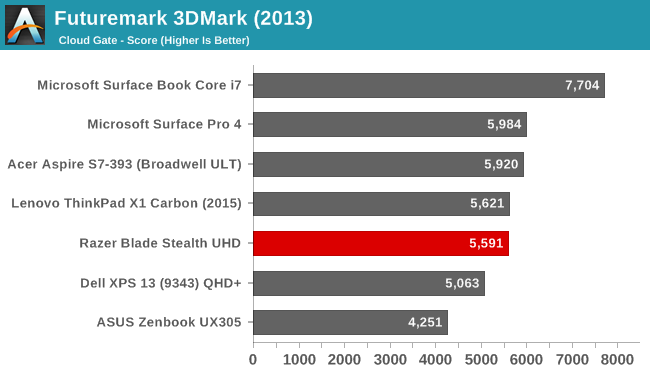

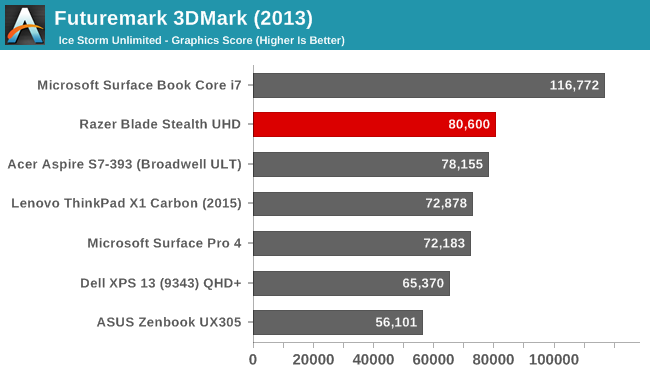
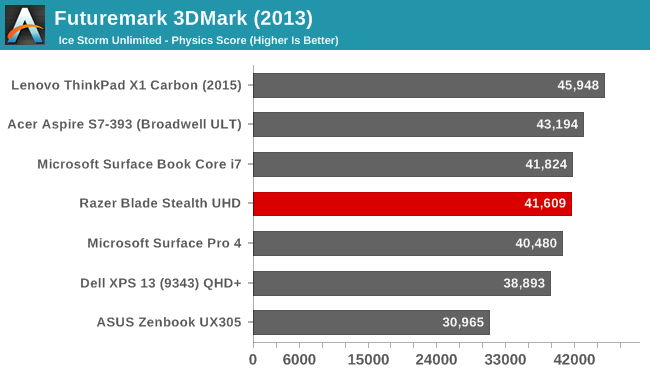
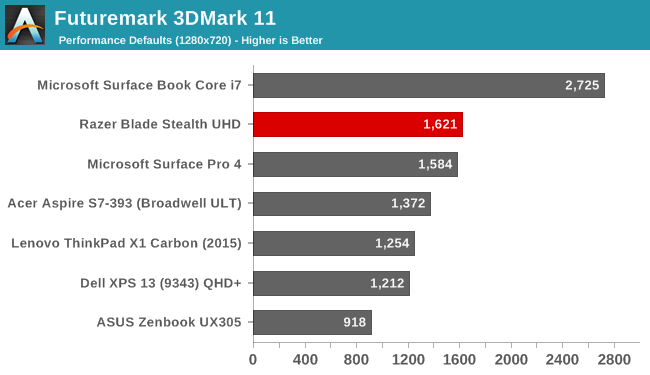
Futuremark’s 3DMark features a set of tests which ramp up in difficultly from Ice Storm Unlimited, which is basically a smartphone class test, up to Fire Strike which can be punishing even on laptops with high end GPUs. The Razer Blade Stealth falls in line with the other systems that leverage HD 520 graphics, but is a long way off of the Surface Book Core i7 with its GT 940M graphics card.
GFXBench
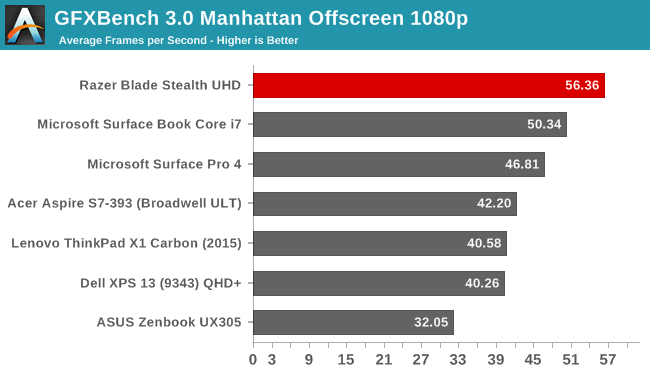
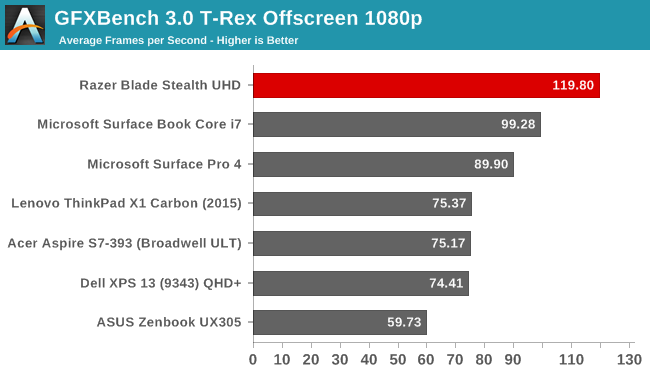
GFXBench has been updated to version 4 on Windows, giving us some new tests to work with. Once we have enough results for a comparison, the new tests will be included as well, but for now we can look at Manhattan and T-Rex. T-Rex is quite a bit lighter of a workload, and the Stealth has no issues running it at 1080p, and the results on Manhattan are decent as well.
Dota 2



Valve’s free to play online multiplayer arena game is a light enough test that it is suitable for devices with integrated graphics. Running at the maximum settings at 1080p can still be a bit too demanding, but our test run on this game is a very difficult section for the GPU so these results should be near the worst case for the graphics processor. Once again the Stealth is no match for the discrete graphics in the Surface Book Core i7, but it holds its own against the other integrated solutions. It would be really interesting to see this with Iris graphics though, but that will have to be another day.
Graphics Conclusion
The Razer Blade Stealth is not a gaming laptop, despite it being sold by a company that has focused on gaming for its entire existence. That is a bit odd, to be honest, but I can see where they were going on price and accept the choice of processor on that basis. The Core i7 version of the HD 520 has a slightly higher frequency on the GPU, which adds a tiny bit more performance over the Core i5, and of course anything that is getting to be CPU limited will struggle less with the i7, but overall the results are pretty much in-line with the other integrated solutions that we’ve tested.
Storage
The age of PCIe based storage is definitely upon us, with most of the new products this year featuring PCIe 3.0 x4 NVMe solutions, and Razer is no exception. They, like most OEMs this year, have gone with the Samsung PM951 as the drive of choice. This is a TLC based drive, and it tends to suffer on write speeds compared to the MLC SM951 version. Read speeds, especially sequential, are very good though. Hopefully we’ll start to see this supplanted by the PM961 which was just announced and which promises better performance, but it would seem Samsung has the lion’s share of the OEM drive market with the PM951.
Razer sent us both the QHD version with a 256 GB drive and the UHD version with the 512 GB drive, so we can see how much the added NAND parallelization adds to the performance.
The 512 GB model has enough NAND that the write speeds are still very good, but you can see the 256 GB version is quite a bit slower, not that 300 MB/s is really slow, but compared to the performance of the MLC version, it is down quite a bit. The 128 GB model is going to likely be closer to 150 MB/s, which is getting into desktop hard drive speeds. It’s great to see the move to PCIe storage, but unfortunately for now everyone seems to be using the TLC drive from Samsung.



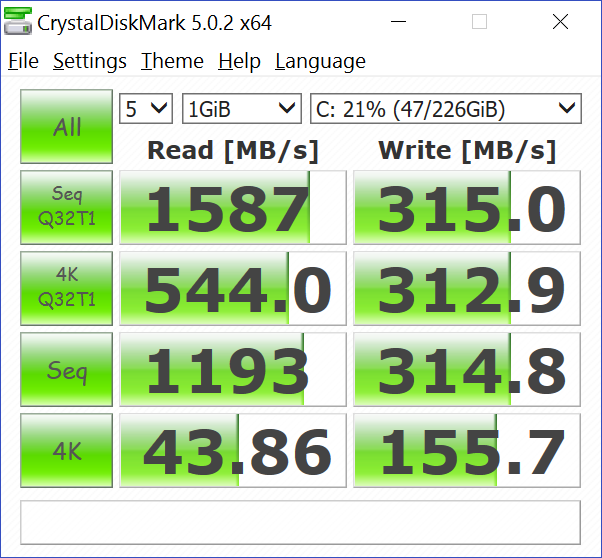








66 Comments
View All Comments
ImSpartacus - Tuesday, March 29, 2016 - link
The battery life is disappointing, but at least seems to be alright otherwise.The keyboard appears like overkill, but at least you can presumably switch to a clean white light.
Keao - Tuesday, March 29, 2016 - link
It is overkill if you just want an ordinary ultrabook indeed. Needs to see if the glowing razer logo on the back can be deactivated too. (You can switch to plain white for sure given it works like the blackwidow chroma that I have)Battery life is really not great but is OK for the kind of processor they have isn't it? What's putting me a lil' off is the fact that to make it a gaming machine you do need to shell out at least some 750 additional bucks. Sure the external case will be re-used supposedly but I'm unsure about the future of this solution (Can evolve quite fast with a new Thunderbolt version and/or replacement of the PCI-e interface?)
zeroqw - Tuesday, March 29, 2016 - link
"Battery life is really not great but is OK for the kind of processor they have isn't it?" nope.. there are quite similar ultrabooks with at least 50% more battery life.Razer put a small battery in the laptop and if you add the backlit keyboard+glowing razer logo to the equation it just makes it even worse. Too bad because I love the design but the battery life is a deal breaker for me.
Duraz0rz - Tuesday, March 29, 2016 - link
You can turn off the logo LED thru Synapse.TheinsanegamerN - Tuesday, March 29, 2016 - link
Wont fix the battery being too small.DanNeely - Tuesday, March 29, 2016 - link
The battery size isn't the main problem; it's in the same general class as other 13" ultrabooks. The problem is that the laptop's efficiency is bad; if they were able to match their competitions efficiency they'd pick up an extra hour or two bringing the QHD model up to the average for a laptop of its size; and leaving the 4k one with only the penalty related to its ultra high res display (both more GPU work to drive it, and more transistors in the panel blocking a larger amount of the backlight).ImSpartacus - Tuesday, March 29, 2016 - link
I think Razer is struggling with both the pixel race and needing to justify the existence of Core.Honestly, a 768p display would be perfect for a 12.5" laptop (maybe 900p for a buy-up). But then you could say that Razer should've made the Core a smidge thicker and put a modest dGPU in there for gaming.
Spunjji - Wednesday, March 30, 2016 - link
Couldn't disagree more about the display. The sooner we get rid of low-DPI panels and the software ecosystem is forced to accept their existence, the better. The problem here isn't the display, it's a lack of engineering experience regarding power efficiency at Razer.BrokenCrayons - Wednesday, March 30, 2016 - link
I disagree with that. Higher resolution displays, while nice looking, offer little to no added functionality after reaching the point where it becomes necessary to scale the interface in order to retain visibility of objects displayed in it. At this point, they're part of the specifications for the sake of specifications war that's vital for product differentiation and marketing, but that's where it ends. Sacrificing capability as in the case of battery life to achieve a pointlessly high resolution shows particularly poor engineering. An Intel GPU in a 12.5 inch laptop display that is unable to drive games at much lower resolutions should be paired with a 1366x768 panel of decent quality with good viewing angles. Anything more than that won't benefit the end user regardless of how much they think they need more pixels.JoeyJoJo123 - Wednesday, March 30, 2016 - link
>should be paired with a 1366x768 panel of decent quality with good viewing angles.Except that's the thing. In the year 2016 there is no such thing as a 1366x768 panel of anything remotely decent quality. Panels of this size are just churned out by the factory for extremely low cost/low margin devices such as $300 laptops at Walmart.
If you're paying ~$1500 for a premium laptop, you should expect an arguably premium display. If you can't play the game at 2560x1440, then run the game at reduced settings, and if that's not enough, begin lowering the resolution, too.
Paying ~$1500 for a premium laptop also comes with the inherent notion you're paying for premium battery life, but you're not getting that here, either.
Replacing a good screen on a laptop with a bad battery leaves you with a laptop with bad screen and bad battery and now you have an even worse value proposition than before.